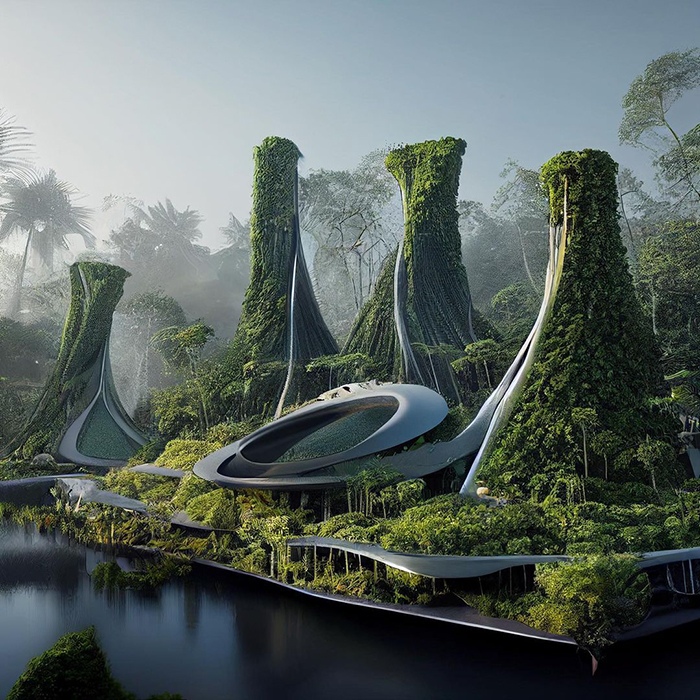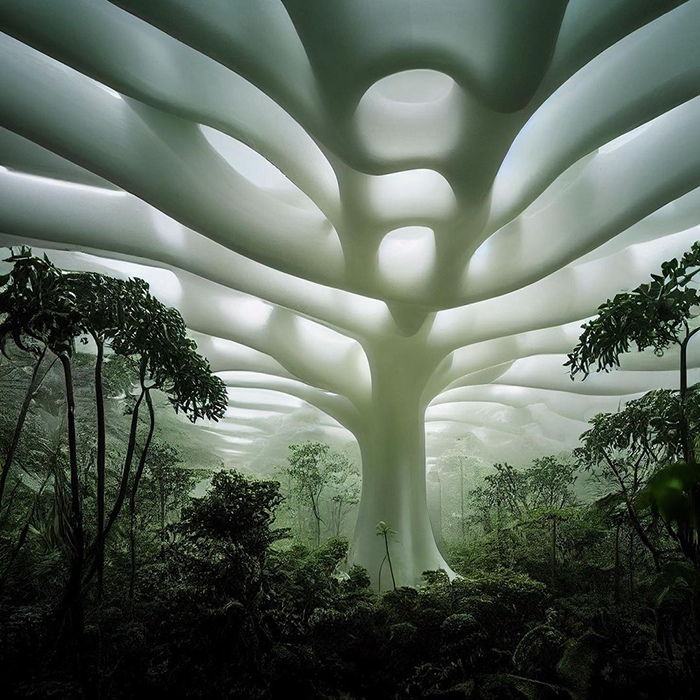
The Unity of Nature and Humans Designed by Diego Castro
Diego Castro, a futuristic architect, uses the advent technology of AI (artificial intelligence) and tools, such as MidJourney and DALL-E 2, to implement his architectural designs. In his designs, he creates a world where nature and buildings or even societies cleanly coexist, where humans can be inspired by and feel respect for nature.
As a veteran in digital creation specializing in architectural visualization, Diego is charging into the frontier of design evolution with powerful AI tools, opening doors to many possibilities which are centered on themes of living peacefully with nature. Combined with new building materials and 3D printing capability, Diego may one day realize the harmonious world he envisions in real life.
We are grateful to Diego for sharing his specialty and design philosophy. Through the unification of humans and nature, we can foresee a better world ahead.

Q: You have designed many fascinating architectural visualizations under MONOMO. What is MONOMO and what is your role in this organization?
A: MONOMO is a brand that was born out of an early entrepreneurial spirit as a Computer-Generated Imagery powerhouse when I was only 23 years old. After working at a renowned architecture practice in South America, I focused on Architectural Visualization, where I was able to produce thousands of CGIs (Computer Generated Imagery), for several continents, only excluding Asia.
My initial role in MONOMO was as a founder and Creative Director. I acted as a Visual artist/architect to produce Architectural renderings with a sharp focus on atmosphere and intangible expression. The brand has expanded to explore the different realms of digital worlds or metaverses, conceptual design, and art via AI CLIP (Contrastive Language Image Pre-Training) Diffusion Models to recreate futuristic bio-focused concepts, with a strong narrative surrounding climate change issues.
Q: Please share with us your background and training in design, especially using AI design tools.
A: Being a self-taught artist in the digital era comes with an additional layer of challenges – you not only had to learn all the 3D CGI traditional software but also be vigilant to the next stages of emerging technologies, so I’m quite used to having more primitive software as an ally on my own creations and explorations. All of this was within a formal architectural education I received in South America and Australia. We live in possibly the fastest changing environment and set of conditions any human has ever experienced before, and with this comes the evolution of AI, in this case, machine learning models that can produce incredible amounts of work in extraordinarily short time frames.
When I found artists like Refik Anadol combining the power of Machine Learning and visualization, through GANS (Generative Adversarial Networks), I knew I had found a very specific objective and started de-constructing the technology for my explorations. This is where DALL.E 2 appeared as it was a ready-to-use text prompt-to-image generator model. Not too long after that I found Midjourney and found myself in the middle of one of the great breakthroughs in these Machine Learning models, as the Stable Diffusion technology combined with the artistic approach of MidJourney, produced not only photorealistic oriented images, but also ones of high aesthetic and cinematic value.
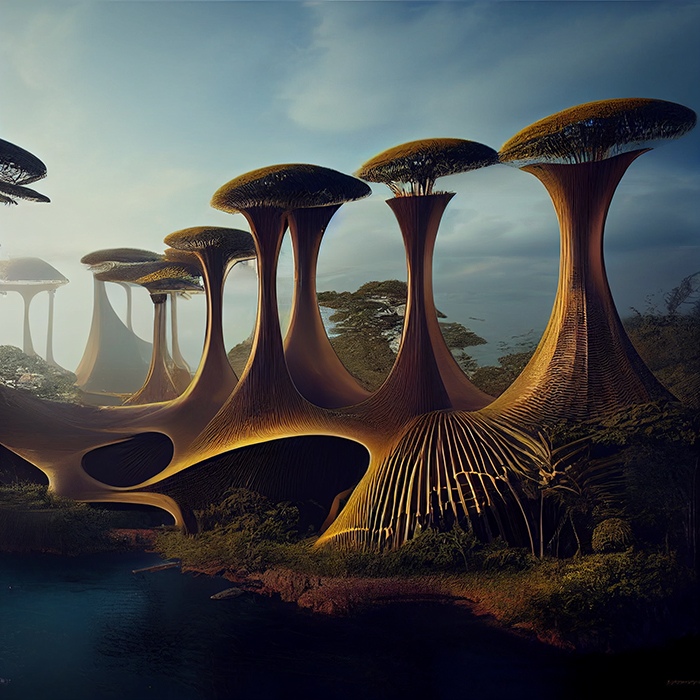
Q: What AI apps are you currently using and what are their primary functions?
A: Many of the AI series I have produced are made with Stable Diffusion and Midjourney, two of the most robust image generators. Due to their available databases of images, they allow you to create sets of images based on text prompts and what I call “AI Discriminator Intuition”, a sort of subtle language exchange with AI to obtain the results you are looking for – through the tools the Beta Midjourney platform in Discord allows you to use: variation, upscaling and re-mastering (this last one is essentially enhancing to a more photorealistic look). This allows a less frictional process between ideation and creation, as the distance has become shorter for the materialization of our own thoughts into reality. Normally it would take you several orders of magnitude of effort to develop a CGI concept (Computer Generated Imagery from traditional 3D software) and validate your own idea. With tools like MidJourney, Dalle2, and Stable Diffusion you can focus more on the quality of content you are producing rather than the techniques you have to perfect to present your ideas. I believe it will definitely work as an advantage for those who want to express their thoughts through visual art, and that want to focus not only on the quality of their content but also on the quality of their own narratives. It also adds a smidge of boldness to your creation process as the use of these new technologies inspires you to think about the future in more innovative and creative ways than before, because the mechanism that you are using to output these pieces comes with the influence not only from base images you can use to influence it but also millions of images from databases that add to your own vision.
Q: What are the main themes in your architectural visualization designs and why?
A: The Naturalized AI series is one of the most recent works at MONOMO; it is the next step in my evolution as a digital creator; they are made to provoke and inspire the minds of individuals and future decision-makers on how a possible vision of our future might look like, where nature and architecture merge or synthesizes in a way that makes them unrecognizable from each other.
“Climate” and “change” are possibly two words that most of our current society knows very well, as it is affecting us daily in every corner of the planet. We are losing a big part of our biodiversity in our ecosystems while raising the temperature for our own living conditions, increasing the amount of freshwater needed to sustain our civilization, acidifying our oceans, and creating islands of residue; we are currently crossing irreversible tipping points as stated by David Attenborough and Johan Rockström in “Breaking Boundaries: The science of our planet”.
I am a huge advocate for the natural environment and I am fascinated by its biodiversity, so this is MONOMOs contribution to the vision of a world where we are one with nature rather than competing or just extracting value from it. It is a vision where nature takes a front seat in the way our main cities and societies are built and inhabited. The balance to present these pieces without losing touch with the familiar is parallel to achieving that synthesized output between nature and architecture. There should be an equilibrium between the presented project and its atmosphere and intention for it to be unrecognizable, where the first one starts and the last one ends. That is where you achieve a true representation of a vision for the future.
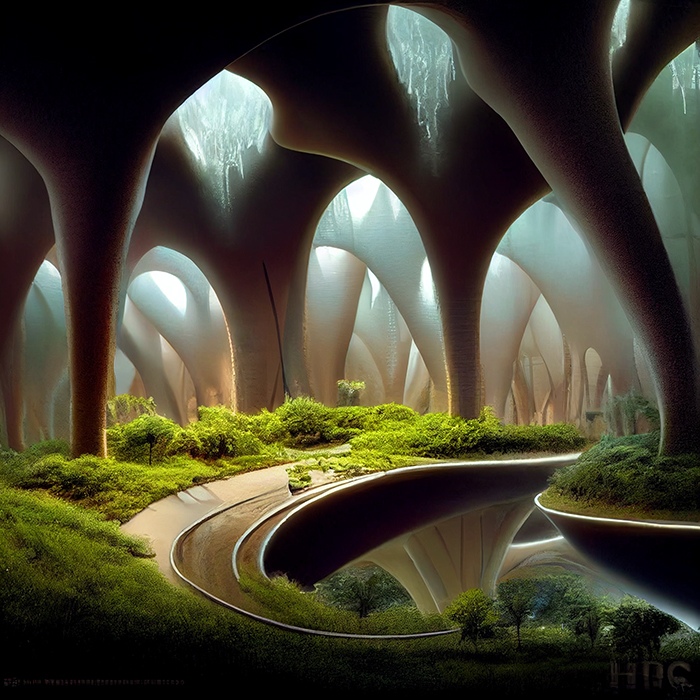
Q: Please share with us some success stories with your designs.
A: There are probably two pieces that have been popular in my work so far in 2022. The first one is the natural meditation structures. For this series I was inspired by envisioning a future where structures like this one act symbiotically with their environment, breathing architectural systems that resemble nature, where the relationship between human society and natural environments becomes one single entity. This was one of the first concepts I started working on when I first started engaging with CLIP tools. I started thinking of structures that would grow organically like trees from the ground that created canopies with tessellated surfaces for walkways and nature havens.
Future technologies will allow us to have more freedom to design systems like this. Harmony between our built architecture and the natural environment is necessary for a better future, where we contribute to the evolution of nature and its ecosystems, while we receive all the benefits that it has been providing to us throughout our civilization’s development.
The second one is the Harvesting Structure Series. This design was inspired by the relationship between natural structures and their environment, especially the fungus ecosystem where the complex underground networks connect hundreds of fungus species across different environments. I related current society to this concept in terms of how crops and productive settings connect a very broad human environment with our produce, normally in Hydroponic warehouses. I wanted to imagine a future where we are able, through chemistry and genetic advancements, to create a world where these hydroponic crops and factories are way more organic and connected to the outside world creating this natural environment that is fresh and open but still productive.
I believe our connection to our natural environment is the only way forward. We need to reduce and improve the boundaries that we have created in order for our society to exist. And we must imagine new ways how to cohabit with as many different species as we can. This makes me think of a brighter future for a world with hope and enthusiasm. I think as I have experienced myself, we are looking for messages that appeal to this disconnect between nature and the development of our society, so I think these series act as a representation of that hope for a better future where we are more surrounded by a natural environment.
Q: What difficulties do you perceive when implementing architectural visualization designs in real life by using AI tools (e.g., defusion/curving, deep tectonics features, and mixing nature with technology, etc.)?
A: We are still on the nascency of these technologies; GANS (Generative Adversarial Networks) only appeared in the last decade, and Diffusion models even later, but there is an explosion of papers and models produced at the present time, just as there have been open source technologies available. So I believe for now AI will aid us to explore new ideas and concepts that we want to validate as narratives that will drive future projects. But I believe integration between the various 3D traditional architectural design software is on the way. As much as I saw the development from orthogonal shapes into organic form and “parametricism” in architecture, I believe we will start to see that threshold between these tools and AI systems.
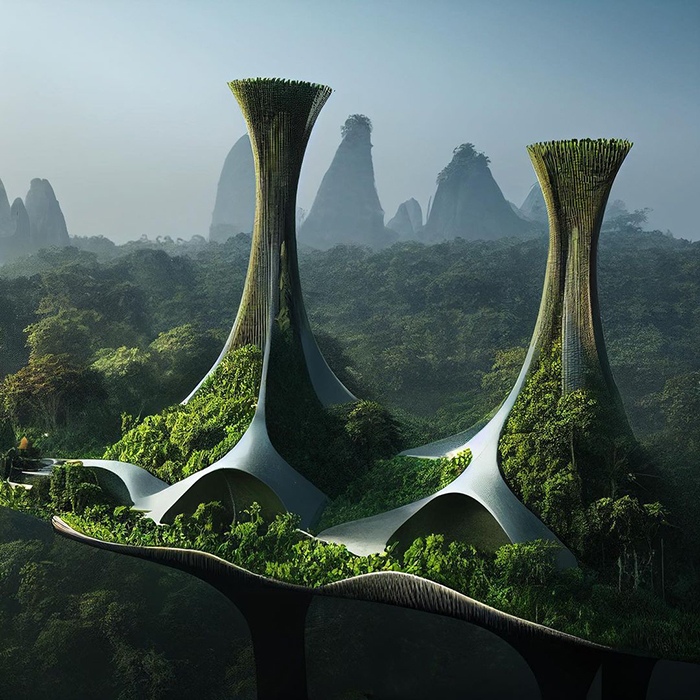
Q: Do you have any current projects that you wish to share with our readers?
A: I am currently working on a new series that has a broader and more abstract scale that is inspired by patterns that we see from satellite photographs of earth. There is a feeling expressed by astronauts and people that have been lucky enough to travel to the edge of space, which gives them that feeling of longing for the familiarity of our planet. I wish to capture this in a series and be able to trigger those emotions and appeal to that thought process.
Q: Is there anything else you would like to tell our readers?
A: This will only come to pass if we believe it can happen and if we imagine it first. As William Arthur Ward said,”only if you can imagine it, you can achieve it. If you can dream it, you can become it”. These presented pieces make us ask “is nature itself art?” and if so, we can now answer the question “can art be sustainable?”.
*****
We thank Diego for sharing his uplifting dream world and we share his hope that we can find the solutions to build this world, emulating nature to a point where there is no boundary between the two.
Instagram of Diego’s MONOMO brand
